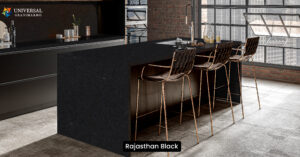Granite is one of the most popular choices for kitchen countertops, and for good reason. Not only does it come in a wide range of colors and styles, but it’s also durable and works well with almost any type of cabinetry. To help you pick the perfect granite for your home, the Natural Stone Experts at Universal Granimarmo share four helpful tips.
1. MATCH THE GRANITE WITH THE CABINETS
There are two main methods to pair granite with cabinets: match the color with the cabinets or pair the veining and marbling. The main way to match granite to your countertops is to select granite that is similar to your filing cabinet but with darker veining. For example, white cabinets look gorgeous with White Spring granite and black, grey, and brown veins. Instead, if you want granite with a contrasting color, choose a stone with veins of color that match your cabinetry. The similar White Spring granite would pair attractively with espresso cabinets.
It may also benefit from looking at standard pairings of granite kitchen slab and cabinetry. Here are some thoughts:
- Neutral medium-brown maple cabinets with grey, beige, and white granite
- You can use Light to medium oak cabinets with a contrasting granite-like Black Pearl
- Dark brown cabinets with green granite.
- Cherry cabinets with granite-like Ubatuba, Verde Peacock, and white granite.

2. Marble
Marble is a classic material in kitchen design schemes. The luxurious and elegant natural stone looks beautiful in almost any setting. Most slabs feature beautiful veining that can add visual interest to your kitchen. A marble countertop or tile immediately makes a room feel high-end and well-designed.
There are a few downsides when it comes to marble slabs. First, it can be a costly option, especially if you choose a style that is rare or imported. Marble is also a softer stone, so it’s easier to scratch and damage. You’ll need to keep it sealed and avoid putting hot or acidic substances to keep the slab looking good and use gentle cleaning products.

3. Quartzite
For another stone option, consider quartzite. It’s the best of both worlds, featuring the beautiful look of marble with the durability of granite. Quartzite is resistant to scratches, heat, and staining so it works well in high-traffic applications like a fast-paced kitchen design. You can get the elegant veining you see in marble without worrying about such careful maintenance.
Quartzite does still require regular staining, similar to granite. This material can get a bit expensive, with the average cost for materials and installation ranging from about $80-$150.
4. Limestone
If affordability and variety are key for your kitchen plans, a tile supplier in Santa Rosa can help you find a great slab of limestone. It has a natural rocky texture and comes in a wide range of natural tones that are perfect for understated design schemes. Limestone fits in especially well in homes with a Mediterranean or rustic theme.
This material is generally pretty affordable, costing around $50 per square foot installed. While it is strong enough to be used as a countertop, remember that limestone is still a softer stone. You will need to take some care so you don’t damage it, and keep it well-sealed.
Factors To Consider When Choosing a Slab
So how do you get the slab that’s best for your kitchen design? Consider the following factors to find the material that will suit you:
- Your Cooking Habits: People who bake a lot may want granite or marble since these smooth services are great for rolling dough. If you need to place hot items on the counter, quartzite may be better.
- Household Design Scheme: Pair a rustic countertop with a more rustic home design, or a sleek counter in a more modern home.
- Maintenance: Be realistic about how often you will perform maintenance such as resealing, since this is important for certain materials.
Conclusion
In our guide, we’ve covered key aspects of choosing and caring for kitchen countertops. We emphasized daily upkeep, long-term maintenance, design choices, and the importance of professional installation. Key points include cleaning spills immediately to avoid stains, using gentle cleaners, and protecting surfaces with hot pads and cutting boards. Repair strategies and deep cleaning can address wear and tear.
Design tips include matching your countertops with cabinets and flooring to create a cohesive look. Selecting the right color and texture is crucial for setting your kitchen’s mood, whether modern, traditional, or rustic.

